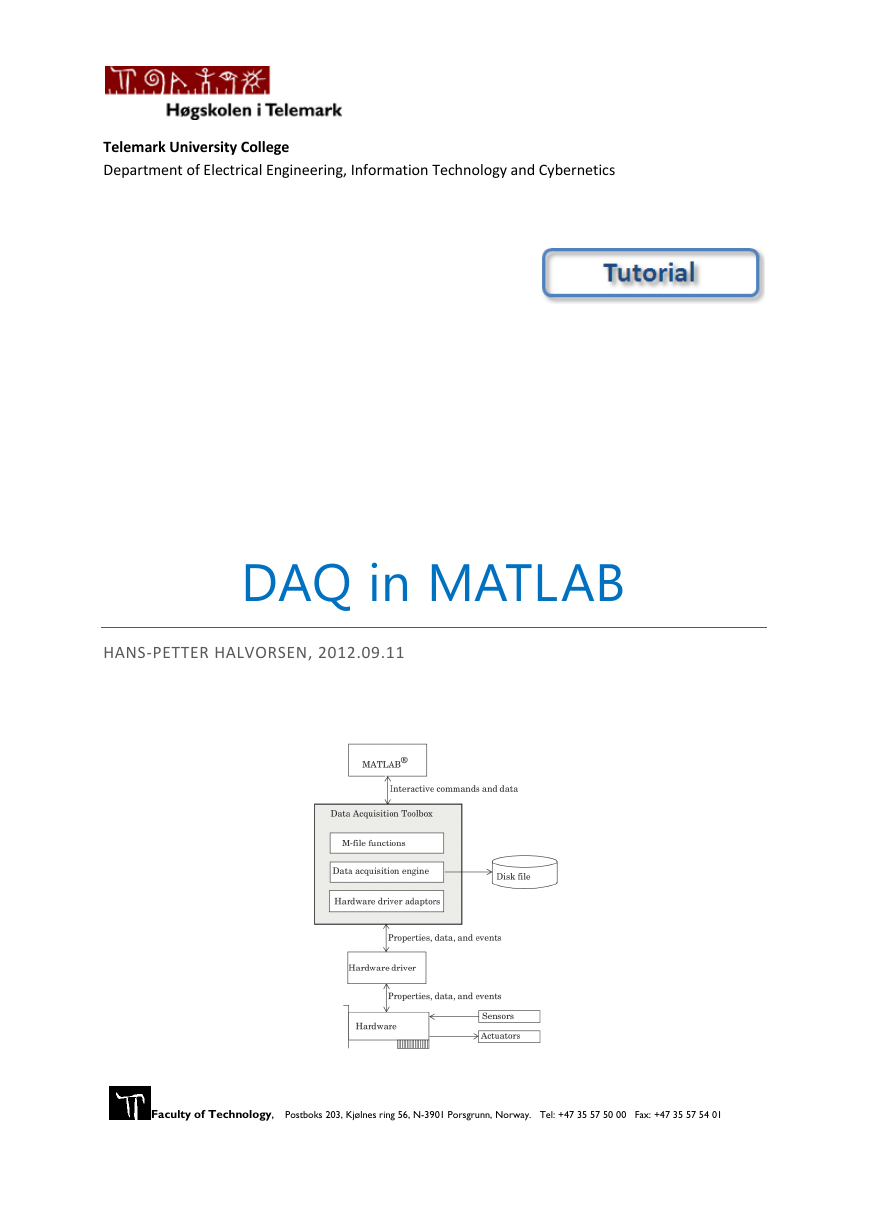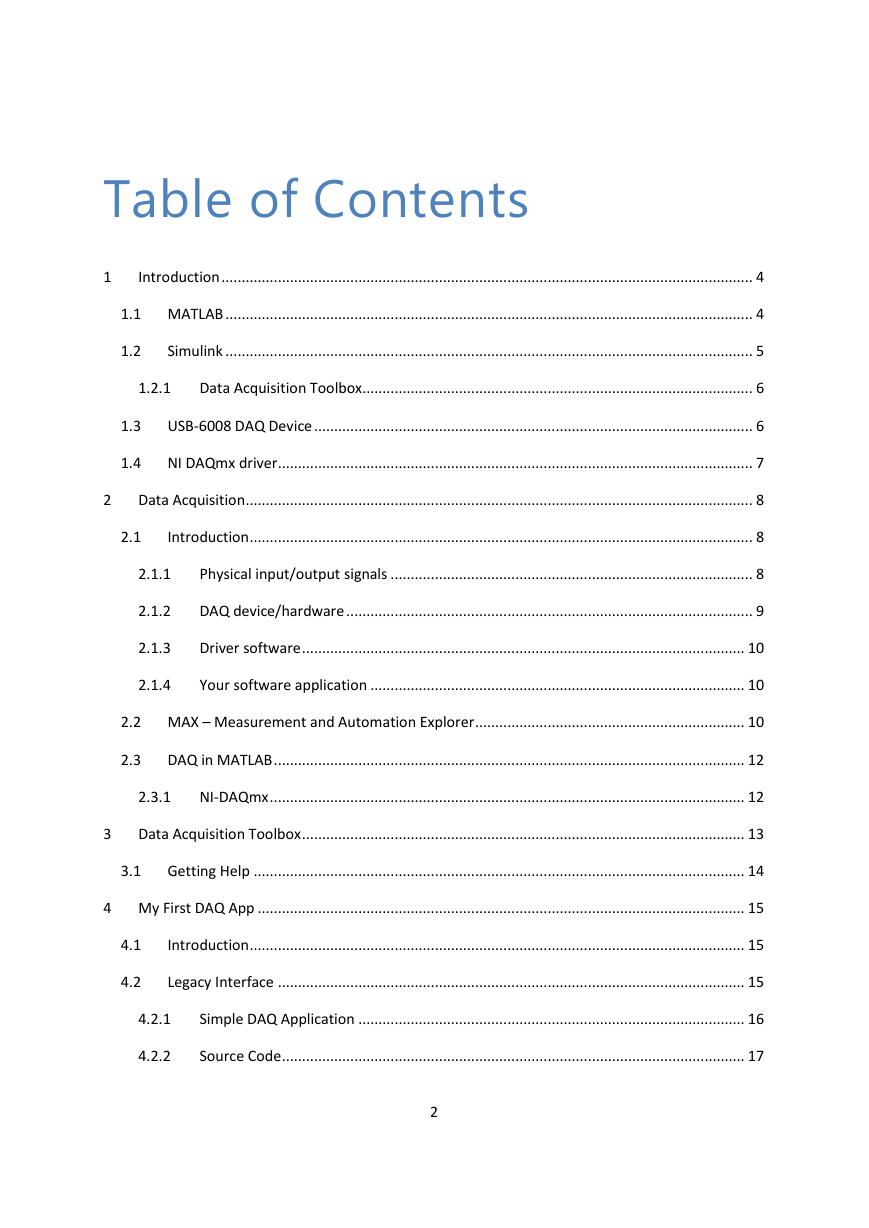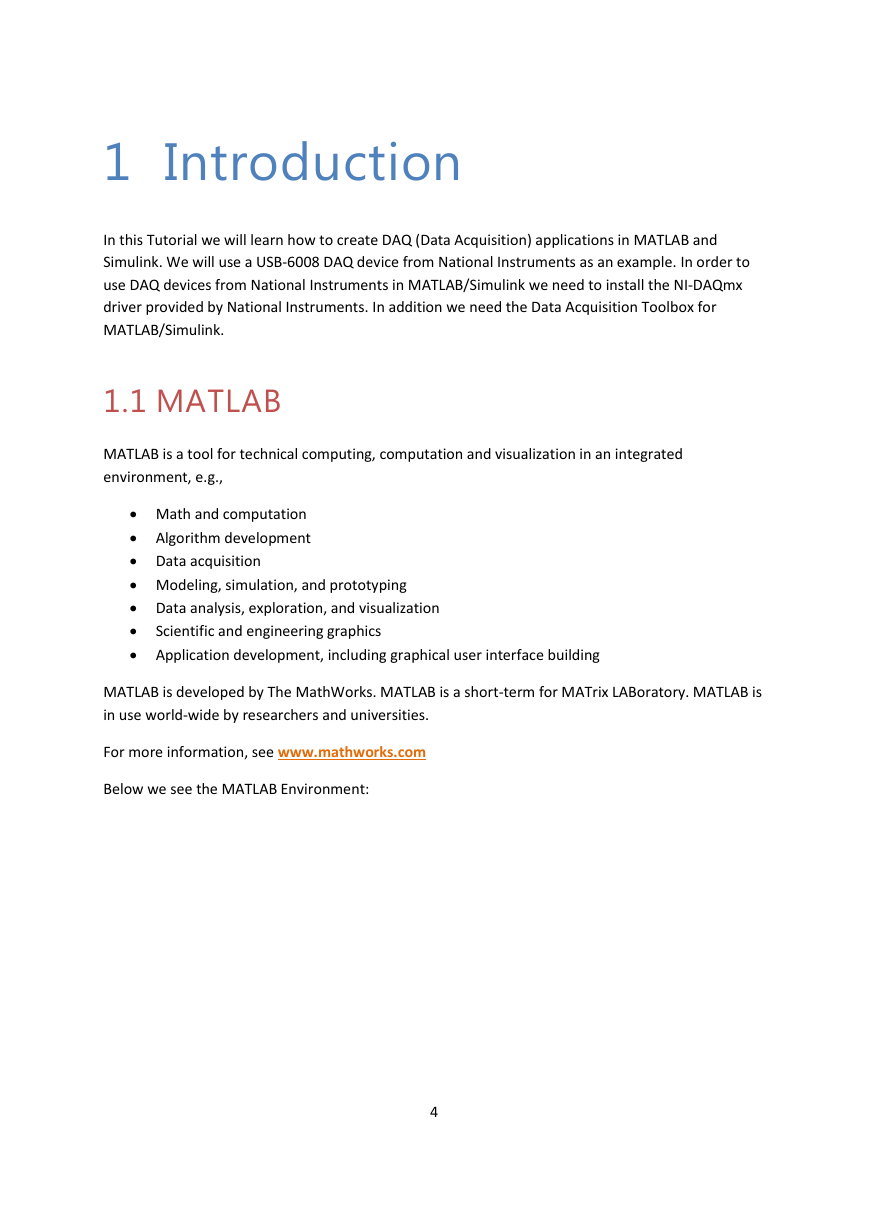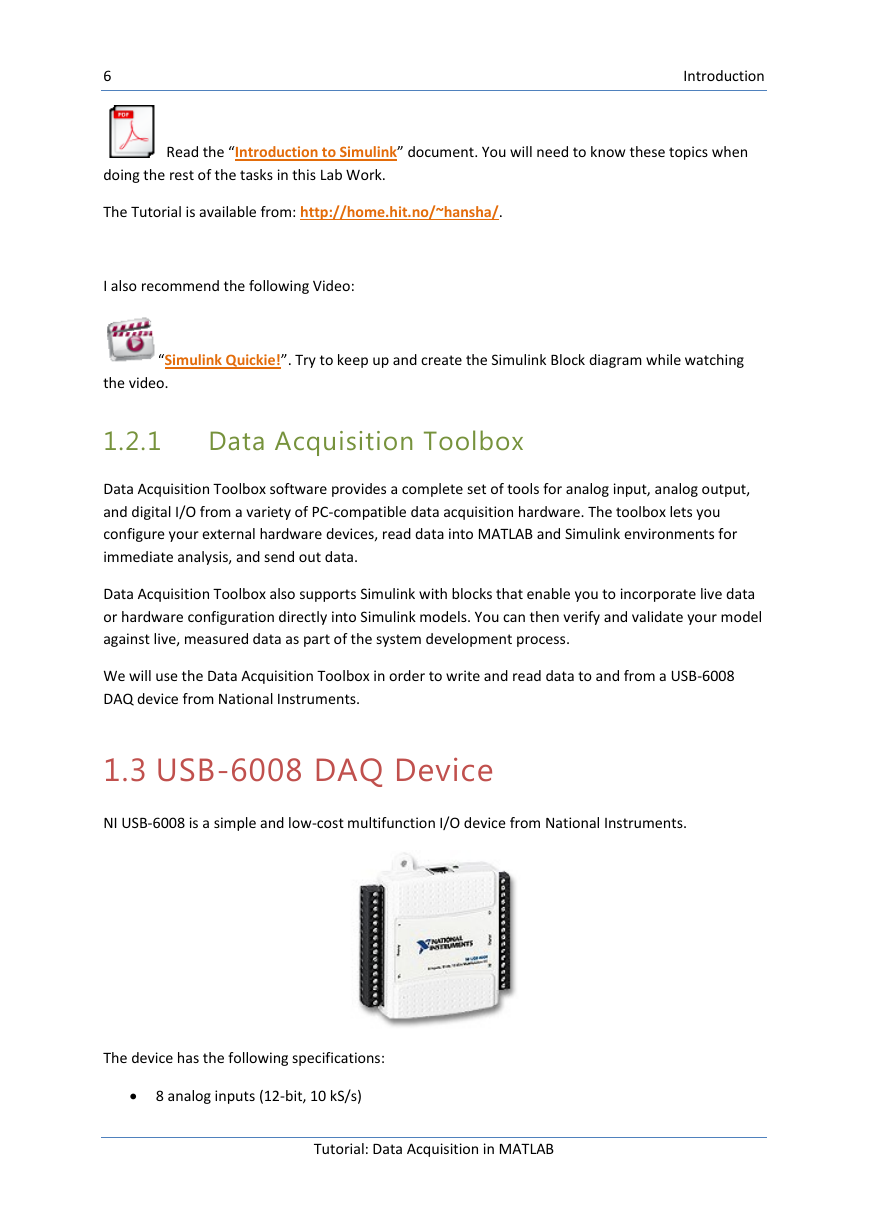Telemark University College
Department of Electrical Engineering, Information Technology and Cybernetics
DAQ in MATLAB
HANS-PETTER HALVORSEN, 2012.09.11
Faculty of Technology, Postboks 203, Kjølnes ring 56, N-3901 Porsgrunn, Norway. Tel: +47 35 57 50 00 Fax: +47 35 57 54 01
�
Table of Contents
1
Introduction .................................................................................................................................... 4
1.1 MATLAB ................................................................................................................................... 4
1.2
Simulink ................................................................................................................................... 5
1.2.1
Data Acquisition Toolbox ................................................................................................. 6
1.3
USB-6008 DAQ Device ............................................................................................................. 6
1.4
NI DAQmx driver ...................................................................................................................... 7
2
Data Acquisition .............................................................................................................................. 8
2.1
Introduction ............................................................................................................................. 8
2.1.1
Physical input/output signals .......................................................................................... 8
2.1.2
DAQ device/hardware ..................................................................................................... 9
2.1.3
Driver software .............................................................................................................. 10
2.1.4
Your software application ............................................................................................. 10
2.2 MAX – Measurement and Automation Explorer ................................................................... 10
2.3
DAQ in MATLAB ..................................................................................................................... 12
2.3.1
NI-DAQmx ...................................................................................................................... 12
3
Data Acquisition Toolbox .............................................................................................................. 13
3.1
Getting Help .......................................................................................................................... 14
4 My First DAQ App ......................................................................................................................... 15
4.1
Introduction ........................................................................................................................... 15
4.2
Legacy Interface .................................................................................................................... 15
4.2.1
Simple DAQ Application ................................................................................................ 16
4.2.2
Source Code ................................................................................................................... 17
2
�
3
Table of Contents
4.3
Session-based Interface......................................................................................................... 18
4.3.1
Summing up ................................................................................................................... 19
5
DAQ in Simulink ............................................................................................................................ 21
5.1
Analog In ................................................................................................................................ 21
5.2
Analog Out ............................................................................................................................. 23
6
Control Application ....................................................................................................................... 26
6.1
Introduction ........................................................................................................................... 26
6.2
Low-pass Filter ....................................................................................................................... 27
6.3
PI Controller ........................................................................................................................... 27
6.4
Process Model ....................................................................................................................... 29
Tutorial: Data Acquisition in MATLAB
�
1 Introduction
In this Tutorial we will learn how to create DAQ (Data Acquisition) applications in MATLAB and
Simulink. We will use a USB-6008 DAQ device from National Instruments as an example. In order to
use DAQ devices from National Instruments in MATLAB/Simulink we need to install the NI-DAQmx
driver provided by National Instruments. In addition we need the Data Acquisition Toolbox for
MATLAB/Simulink.
1.1 MATLAB
MATLAB is a tool for technical computing, computation and visualization in an integrated
environment, e.g.,
Math and computation
Algorithm development
Data acquisition
Modeling, simulation, and prototyping
Data analysis, exploration, and visualization
Scientific and engineering graphics
Application development, including graphical user interface building
MATLAB is developed by The MathWorks. MATLAB is a short-term for MATrix LABoratory. MATLAB is
in use world-wide by researchers and universities.
For more information, see www.mathworks.com
Below we see the MATLAB Environment:
4
�
5
Introduction
MATLAB has the following windows:
Command Window
Command History
Workspace
Current Directory
The Command window is the main window. Use the Command Window to enter variables and to run
functions and M-files scripts (more about m-files later).
Watch the following “Getting Started with MATLAB” video:
http://www.mathworks.com/demos/matlab/getting-started-with-matlab-video-tutorial.html
1.2 Simulink
Simulink, developed by The MathWorks, is a commercial tool for modeling, simulating and analyzing
dynamic systems. Its primary interface is a graphical block diagramming tool and a customizable set
of block libraries. It offers tight integration with the rest of the MATLAB environment and can either
drive MATLAB or be scripted from it. Simulink is widely used in control theory and digital signal
processing for simulation and design.
Basic information about Simulink can be found here:
Watch the video Getting Started with Simulink by The MathWorks.
Tutorial: Data Acquisition in MATLAB
�
6
Introduction
Read the “Introduction to Simulink” document. You will need to know these topics when
doing the rest of the tasks in this Lab Work.
The Tutorial is available from: http://home.hit.no/~hansha/.
I also recommend the following Video:
“Simulink Quickie!”. Try to keep up and create the Simulink Block diagram while watching
the video.
1.2.1
Data Acquisition Toolbox
Data Acquisition Toolbox software provides a complete set of tools for analog input, analog output,
and digital I/O from a variety of PC-compatible data acquisition hardware. The toolbox lets you
configure your external hardware devices, read data into MATLAB and Simulink environments for
immediate analysis, and send out data.
Data Acquisition Toolbox also supports Simulink with blocks that enable you to incorporate live data
or hardware configuration directly into Simulink models. You can then verify and validate your model
against live, measured data as part of the system development process.
We will use the Data Acquisition Toolbox in order to write and read data to and from a USB-6008
DAQ device from National Instruments.
1.3 USB-6008 DAQ Device
NI USB-6008 is a simple and low-cost multifunction I/O device from National Instruments.
The device has the following specifications:
8 analog inputs (12-bit, 10 kS/s)
Tutorial: Data Acquisition in MATLAB
�
7
Introduction
2 analog outputs (12-bit, 150 S/s)
12 digital I/O
USB connection, No extra power-supply neeeded
Compatible with LabVIEW, LabWindows/CVI, and Measurement Studio for Visual Studio .NET
NI-DAQmx driver software
The NI USB-6008 is well suited for education purposes due to its small size and easy USB connection.
Note! The 64-bit version of Data Acquisition Toolbox supports National Instruments devices that can
be used with the “session-based interface” (more about this later). For other supported NI data
acquisition devices, you must use the 32-bit version of Data Acquisition Toolbox and MATLAB. The
32-bit versions of Data Acquisition Toolbox and MATLAB can be installed on a 64-bit Windows OS.
1.4 NI DAQmx driver
You need to install the DAQmx driver in order to use it in MATLAB.
Tutorial: Data Acquisition in MATLAB
�
2 Data Acquisition
2.1 Introduction
The purpose of data acquisition is to measure an electrical or physical phenomenon such as voltage,
current, temperature, pressure, or sound. PC-based data acquisition uses a combination of modular
hardware, application software, and a computer to take measurements. While each data acquisition
system is defined by its application requirements, every system shares a common goal of acquiring,
analyzing, and presenting information. Data acquisition systems incorporate signals, sensors,
actuators, signal conditioning, data acquisition devices, and application software.
So summing up, Data Acquisition is the process of:
Acquiring signals from real-world phenomena
Digitizing the signals
Analyzing, presenting and saving the data
The DAQ system has the following parts involved, see Figure:
The parts are:
Physical input/output signals
DAQ device/hardware
Driver software
Your software application (Application software)
2.1.1
Physical input/output signals
8
�
















 2023年江西萍乡中考道德与法治真题及答案.doc
2023年江西萍乡中考道德与法治真题及答案.doc 2012年重庆南川中考生物真题及答案.doc
2012年重庆南川中考生物真题及答案.doc 2013年江西师范大学地理学综合及文艺理论基础考研真题.doc
2013年江西师范大学地理学综合及文艺理论基础考研真题.doc 2020年四川甘孜小升初语文真题及答案I卷.doc
2020年四川甘孜小升初语文真题及答案I卷.doc 2020年注册岩土工程师专业基础考试真题及答案.doc
2020年注册岩土工程师专业基础考试真题及答案.doc 2023-2024学年福建省厦门市九年级上学期数学月考试题及答案.doc
2023-2024学年福建省厦门市九年级上学期数学月考试题及答案.doc 2021-2022学年辽宁省沈阳市大东区九年级上学期语文期末试题及答案.doc
2021-2022学年辽宁省沈阳市大东区九年级上学期语文期末试题及答案.doc 2022-2023学年北京东城区初三第一学期物理期末试卷及答案.doc
2022-2023学年北京东城区初三第一学期物理期末试卷及答案.doc 2018上半年江西教师资格初中地理学科知识与教学能力真题及答案.doc
2018上半年江西教师资格初中地理学科知识与教学能力真题及答案.doc 2012年河北国家公务员申论考试真题及答案-省级.doc
2012年河北国家公务员申论考试真题及答案-省级.doc 2020-2021学年江苏省扬州市江都区邵樊片九年级上学期数学第一次质量检测试题及答案.doc
2020-2021学年江苏省扬州市江都区邵樊片九年级上学期数学第一次质量检测试题及答案.doc 2022下半年黑龙江教师资格证中学综合素质真题及答案.doc
2022下半年黑龙江教师资格证中学综合素质真题及答案.doc